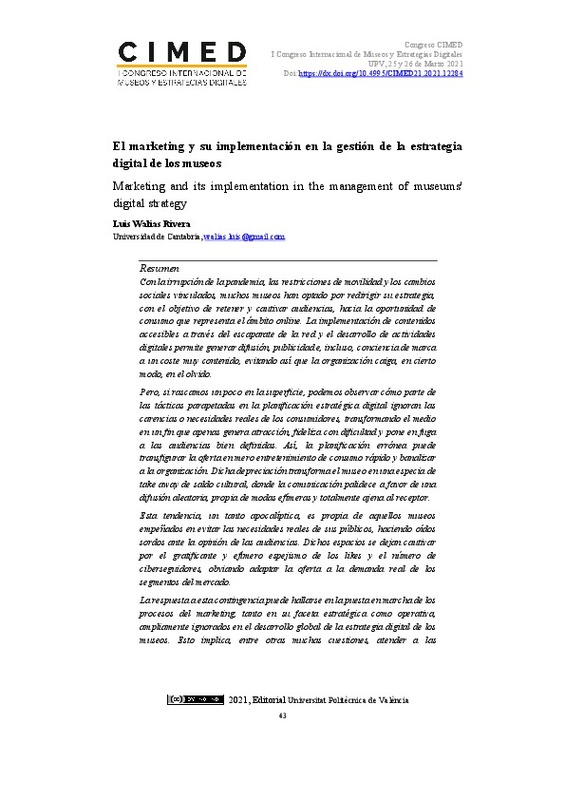|
Resumen:
|
[EN] With the emergence of the pandemic, mobility restrictions and related social changes, many museums have chosen to redirect their strategy, with the aim of retaining and captivating audiences, towards ...[+]
[EN] With the emergence of the pandemic, mobility restrictions and related social changes, many museums have chosen to redirect their strategy, with the aim of retaining and captivating audiences, towards the consumption opportunity that the online sphere represents. The implementation of accessible content through the network's showcase and the development of digital activities allows the generation of diffusion, publicity and even brand awareness at a very low cost, thus preventing the organization from falling, in a way, into oblivion. But, if we scratch a little on the surface, we can observe how part of the tactics hidden in digital strategic planning ignore the deficiencies or real needs of consumers, transforming the medium into an end that hardly generates attraction, loyalty with difficulty and puts in leak to well-defined audiences. Thus, wrong planning can transform the offer into mere fast-paced entertainment and trivialize the organization. This depreciation transforms the museum into a kind of take away with a cultural balance, where communication pales in favor of a random diffusion, typical of ephemeral fashions and totally alien to the recipient. This somewhat apocalyptic trend is typical of those museums determined to avoid the real needs of their audiences and turn a deaf ear to their opinion. These spaces are captivated by the gratifying and ephemeral mirage of likes and the number of cyber-followers, ignoring adapting the offer to the real demand of the market segments. The response to this contingency can be found in the implementation of marketing processes, both in their strategic and operational aspects, widely ignored in the global development of museums' digital strategy. This implies, among many other issues, attending to the real needs of the audiences, to later seduce and retain them correctly. In conclusion, this article aims to raise a critique of the digital strategy management model followed for a long time by countless museums, exponentially implemented today as an emergency solution to the ensuing health crisis. Both to bring the museum ship to fruition and to effectively reach remote audiences, without a doubt, strategy, creativity and resilience are required, but we must not ignore the marketing processes, guarantors of the ability to channel these institutions towards its reason for being and social mission.
[-]
[ES] Con la irrupción de la pandemia, las restricciones de movilidad y los cambios sociales vinculados, muchos museos han optado por redirigir su estrategia, con el objetivo de retener y cautivar audiencias, hacia la ...[+]
[ES] Con la irrupción de la pandemia, las restricciones de movilidad y los cambios sociales vinculados, muchos museos han optado por redirigir su estrategia, con el objetivo de retener y cautivar audiencias, hacia la oportunidad de consumo que representa el ámbito online. La implementación de contenidos accesibles a través del escaparate de la red y el desarrollo de actividades digitales permite generar difusión, publicidad e, incluso, conciencia de marca a un coste muy contenido, evitando así que la organización caiga, en cierto modo, en el olvido. Pero, si rascamos un poco en la superficie, podemos observar como parte de las tácticas parapetadas en la planificación estratégica digital ignoran las carencias o necesidades reales de los consumidores, transformando el medio en un fin que apenas genera atracción, fideliza con dificultad y pone en fuga a las audiencias bien definidas. Así, la planificación errónea puede transfigurar la oferta en mero entretenimiento de consumo rápido y banalizar a la organización. Dicha depreciación transforma el museo en una especia de take away de saldo cultural, donde la comunicación palidece a favor de una difusión aleatoria, propia de modas efímeras y totalmente ajena al receptor. Esta tendencia, un tanto apocalíptica, es propia de aquellos museos empeñados en evitar las necesidades reales de sus públicos, haciendo oídos sordos ante la opinión de las audiencias. Dichos espacios se dejan cautivar por el gratificante y efímero espejismo de los likes y el número de ciberseguidores, obviando adaptar la oferta a la demanda real de los segmentos del mercado. La respuesta a esta contingencia puede hallarse en la puesta en marcha de los procesos del marketing, tanto en su faceta estratégica como operativa, ampliamente ignorados en el desarrollo global de la estrategia digital de los museos. Esto implica, entre otras muchas cuestiones, atender a las necesidades reales de las audiencias, para más tarde seducirlas y fidelizarlas con corrección. En conclusión, la presente propuesta pretende elevar una crítica hacia el modelo gestión de la estrategia digital seguido desde hace tiempo por infinidad de museos, implementado exponencialmente en la actualidad como solución de emergencia ante la crisis sanitaria sobrevenida. Tanto para llevar a buen puerto la nave del museo como para alcanzar eficazmente a las audiencias en remoto se precisa, sin duda, de estrategia, creatividad y resiliencia, pero no debemos obviar a los procesos del marketing, garantes de capacidad para encauzar a estas instituciones hacia su razón de ser y misión social.
[-]
|









